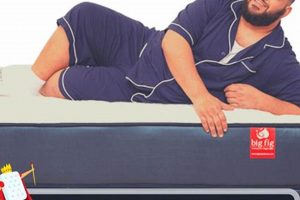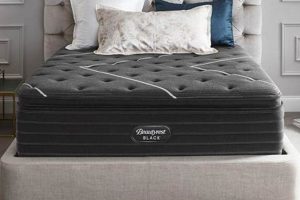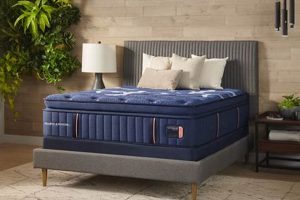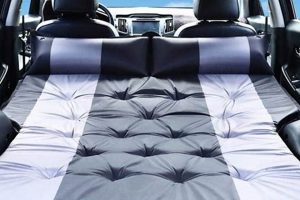A sleep surface offering variable levels of support to accommodate individual preferences is gaining traction within the bedding market. This type of product allows users to modify the feel of the mattress, ranging from soft to firm, and is often achieved through adjustable air chambers, internal support layers, or removable comfort layers. As an example, a user might select a firmer setting for back support and a softer setting for side sleeping.
The significance of a customizable sleep surface lies in its potential to improve sleep quality and address diverse comfort needs. This is particularly relevant for individuals with changing physical conditions, couples with differing firmness preferences, or those seeking to optimize spinal alignment. Historically, mattress selection involved a single fixed firmness level. These customizable products represent an evolution towards personalized sleep solutions, offering adaptability that traditional mattresses lack.
The subsequent sections will examine the various technologies employed in these mattresses, the factors to consider when evaluating their suitability, and a comparison of leading models currently available. Furthermore, the discussion will extend to the long-term benefits and potential drawbacks associated with this category of sleep system.
Selecting a Customizable Sleep System
Proper selection requires careful evaluation of construction, adjustability mechanisms, and individual sleep needs.
Tip 1: Research Adjustment Mechanisms: Understand the method by which firmness is altered. Air chamber systems, layered foam configurations, and internal support adjustments offer varying degrees of control and durability. Evaluate each system’s responsiveness and potential for unevenness.
Tip 2: Evaluate Firmness Range: Assess the spectrum of firmness levels offered. The system should accommodate the user’s preferred sleep positions and provide sufficient support for differing body weights. A wider range allows for greater customization as needs evolve.
Tip 3: Assess Edge Support: Firmer edges provide stability when sitting or sleeping near the perimeter. Edge support is often compromised in adjustable models; therefore, it warrants specific examination. Inadequate edge support can reduce usable sleep surface.
Tip 4: Consider Motion Isolation: Adjustable systems utilizing air chambers may exhibit less motion isolation than traditional foam mattresses. If co-sleeping, assess the mattress’s ability to minimize the transfer of movement between sleeping partners.
Tip 5: Scrutinize Materials and Construction: Longevity and performance are directly related to material quality. Examine the density of foams, the durability of air chambers, and the quality of the mattress cover. Higher-quality materials contribute to a more consistent and enduring sleep experience.
Tip 6: Review Warranty and Trial Periods: A comprehensive warranty and generous trial period offer reassurance regarding product durability and suitability. Review the terms and conditions carefully, paying attention to coverage specifics and potential return policies.
Tip 7: Consider Professional Recommendations: Consulting with a sleep specialist or healthcare professional can provide personalized guidance. An expert can assess individual needs and provide recommendations based on health conditions or sleep disorders.
Prioritizing these considerations contributes to a more informed decision, optimizing the potential benefits derived from a customizable sleep system.
The subsequent sections will delve into specific product comparisons and address the potential long-term implications of choosing this type of mattress.
1. Customization Capabilities
Customization capabilities are paramount in determining the suitability of an adjustable firmness mattress. The extent to which a sleep surface can be tailored to individual needs directly influences sleep quality and user satisfaction. Therefore, a thorough evaluation of these capabilities is critical.
- Range of Firmness Settings
The breadth of available firmness settings dictates the precision with which a user can dial in their ideal comfort level. A mattress offering only a few settings may not adequately address nuanced preferences, while a mattress with a wide range provides granular control. For example, an individual recovering from a back injury may require minute adjustments to alleviate pressure points. Insufficient adjustability could negate the potential benefits of an adjustable mattress.
- Independent Zone Adjustability
The ability to independently adjust firmness in different zones of the mattress, such as head, shoulders, and hips, offers enhanced customization. This feature is particularly valuable for couples with disparate sleep preferences or individuals with specific support requirements in certain areas. Without independent zoning, a mattress may provide inadequate support in one region while being overly firm in another, leading to discomfort and compromised spinal alignment.
- Responsiveness of Adjustment Mechanism
The speed and ease with which the mattress responds to adjustments influence the user experience. A slow or cumbersome adjustment process can discourage experimentation and hinder the ability to fine-tune the sleep surface. Conversely, a responsive and intuitive mechanism promotes frequent adjustments, allowing users to adapt to changing needs, such as variations in sleep position or physical condition.
- Accuracy and Consistency of Firmness Levels
The consistency with which a selected firmness level is maintained across the mattress surface is a crucial indicator of quality. Inaccurate or inconsistent firmness can lead to uneven support and discomfort. For example, a user selecting a “medium” firmness setting should expect a uniform feel throughout the sleep surface. Discrepancies in firmness compromise the intended benefits of adjustability.
The interaction of these facets directly impacts the overall value proposition. It will determine its capability in catering to diverse needs. It will also influence user satisfaction. A mattress excelling in these capabilities represents a significant investment in sleep quality and long-term comfort.
2. Support System Integrity
The structural foundation of any sleep surface, and especially a best adjustable firmness mattress, dictates its capacity to provide adequate spinal alignment and pressure relief. Compromised integrity in the support system undermines the benefits of adjustable features. Rigidity must be paired with adaptability, in this case.
- Core Material Density and Composition
The de
nsity and composition of the core material directly affect the mattress’s capacity to resist deformation over time. High-density foams or robust coil systems maintain their structural integrity, preventing sagging and ensuring consistent support. A core composed of low-density materials is prone to degradation, leading to uneven support and a diminished lifespan. For example, a mattress with a foam core lacking adequate density may initially provide comfort, but it may deteriorate rapidly under sustained weight, negating the intended benefits of adjustability. - Zoned Support Implementation
Zoned support systems are engineered to provide targeted support to different regions of the body, such as the lumbar spine and shoulders. Proper implementation of zoned support ensures that each area receives the appropriate level of firmness, promoting optimal spinal alignment. Inadequate zoning can result in pressure points and discomfort. As an illustration, a mattress lacking sufficient lumbar support may exacerbate back pain, regardless of adjustable firmness settings.
- Reinforcement of Edge Support
Edge support is a crucial element for maintaining stability and maximizing the usable sleep surface. Reinforced edges prevent the mattress from collapsing under pressure, particularly along the perimeter. Lack of edge support can lead to a feeling of instability and reduce the overall sleep area. As a result, an individual sleeping near the edge of the mattress may experience discomfort and a heightened risk of falling, even with adjustable firmness features.
- Durability of Adjustment Mechanisms
The reliability and longevity of the mechanisms responsible for adjusting firmness are essential for sustaining the intended performance. Air chambers, internal support structures, or layered foam configurations must be constructed from durable materials capable of withstanding repeated adjustments without failure. A malfunctioning adjustment mechanism renders the adjustability feature useless and can compromise the overall structural integrity of the mattress, reducing its capacity to provide uniform support.
These interconnected elements contribute to the overall integrity of the support system and, by extension, the efficacy of a best adjustable firmness mattress. Without a robust and well-engineered foundation, the benefits of adjustable features are significantly diminished, potentially leading to compromised sleep quality and reduced product lifespan.
3. Material Durability
Material durability is a crucial determinant of long-term value and performance within the adjustable firmness mattress category. The lifespan of these systems is directly correlated to the quality and resilience of their constituent components. Inferior materials degrade prematurely, compromising support and adjustability. Therefore, a thorough assessment of material durability is essential when evaluating a mattress of this type.
- Foam Density and Resilience
The density of foam layers within the mattress directly impacts its ability to withstand compression and maintain its shape over time. High-density foams offer greater resistance to sagging and indentation, providing consistent support throughout the product’s lifespan. Low-density foams are more susceptible to degradation, leading to uneven support and reduced comfort. For example, a mattress with a high-density memory foam comfort layer will likely retain its original contours and support characteristics for a longer period than a mattress with a low-density counterpart. The difference is akin to the distinction between a well-maintained road and one riddled with potholes; the former provides a smooth and consistent journey, while the latter offers a bumpy and unpredictable experience.
- Air Chamber Construction
For mattresses utilizing air chamber systems, the quality and construction of the air bladders are paramount. The material used in these chambers must be resistant to punctures, leaks, and degradation caused by repeated inflation and deflation. Weak seams or thin materials can compromise the air chamber’s integrity, leading to uneven firmness and eventual failure. An analogy can be drawn to the construction of a high-performance tire versus a low-quality inflatable toy; one is designed for rigorous use and longevity, while the other is prone to damage and deflation. Therefore, robust air chamber construction is a key indicator of long-term durability in these types of mattresses.
- Fabric and Stitching Quality
The outer fabric and stitching quality contribute significantly to the overall durability of the mattress. A robust, tightly woven fabric protects the inner components from wear and tear, while reinforced stitching prevents seams from splitting or unraveling. Inadequate fabric quality can lead to premature wear, staining, and susceptibility to damage from spills or allergens. Consider the difference between a tailor-made suit crafted from high-quality wool and a mass-produced garment made from inexpensive synthetic fibers; one is built to last and withstand repeated wear, while the other is prone to damage and degradation. Similarly, a mattress with high-quality fabric and stitching will provide greater protection and durability over the long term.
- Component Interfacing and Bonding
The manner in which different components of the mattress are connected and bonded together significantly impacts its overall durability. Securely bonded layers prevent shifting and separation, maintaining the mattress’s structural integrity and preventing the development of pressure points. Poorly bonded components can lead to uneven support and premature wear. The integration of components is not dissimilar to the construction of a high-quality piece of furniture compared to a poorly assembled one. A well-constructed object, where all parts work in harmony, will provide extended and robust use.
In conclusion, the material durability of a best adjustable firmness mattress is a multifaceted consideration that encompasses foam density, air chamber construction, fabric quality, and component interfacing. Selecting a mattress constructed from high-quality, durable materials is essential for ensuring long-term performance, consistent support, and a sustained sleep experience. Failure to prioritize material durability can lead to premature wear, compromised comfort, and ultimately, a diminished return on investment.
4. Motion Isolation Performance
Motion isolation performance is a critical attribute of any mattress, particularly for co-sleepers. Within the category of adjustable firmness mattresses, this characteristic warrants careful consideration due to the potential for certain adjustment mechanisms to exacerbate motion transfer.
- Air Chamber Interconnectivity
Adjustable firmness mattresses that utilize interconnected air chambers may exhibit reduced motion isolation compared to mattresses with individually encased coils or solid foam cores. When one sleeper moves, the air pressure within the interconnected chambers shifts, potentially disturbing the other sleeper. For example, a partner tossing and turning could cause noticeable pressure fluctuations across the sleep surface, disrupting the other individual’s rest. The degree of interconnectivity
directly impacts the extent of motion transfer. Mattresses with fully independent air chambers mitigate this effect, but they may also offer less uniform support across the entire surface. - Foam Layer Damping Characteristics
The composition and density of foam layers positioned above the support core play a crucial role in absorbing and dampening motion. High-density memory foam or latex layers effectively isolate movement by preventing its propagation across the mattress surface. Conversely, less dense or more responsive foams may amplify motion transfer, increasing the likelihood of disturbance. A mattress with a thick layer of high-density memory foam can effectively minimize the impact of a partner’s movements, whereas a mattress with only a thin layer of less dense foam may not provide adequate motion isolation.
- Edge Support Construction and Motion Transfer
The edge support system also influences motion isolation performance. Weak or non-existent edge support allows movement to transfer more readily to the perimeter of the mattress, potentially disturbing a sleeper positioned near the edge. Reinforced edges, constructed from high-density foam or steel coils, create a more stable boundary, limiting the propagation of motion. A well-supported edge reduces the likelihood of a sleeper being disturbed by a partner getting in or out of bed.
- Mattress Construction and Damping Efficiency
The layering and arrangement of materials within the mattress influence its ability to dissipate energy from movement. Layering viscoelastic foam over a core is more effective than placing the core directly under the sleep surface. Using more of these materials provides added damping efficiency. This is because the top layer compresses, distributing the point of contact over a larger area. Damping efficiency increases isolation and can reduce the amount of movement felt.
Motion isolation performance is a key differentiator among best adjustable firmness mattress options. Consumers should carefully evaluate this characteristic, especially if sharing the bed, and consider the trade-offs between adjustability and motion isolation when making their selection. Prioritizing models with independent air chambers, high-density foam layers, and robust edge support systems can mitigate the potential for motion disturbance and contribute to a more restful sleep experience.
5. Long-Term Value
The long-term value associated with an adjustable firmness mattress extends beyond the initial purchase price, encompassing factors such as durability, adaptability to changing needs, and potential health benefits. An initial higher investment in a superior model may translate to considerable savings over time, avoiding the need for frequent replacements or supplemental comfort solutions. For example, a consumer who purchases a lower-priced, less durable mattress may find they need to replace it within a few years, effectively doubling their expenditure compared to investing in a higher-quality mattress with a longer lifespan.
Furthermore, the adaptability of adjustable firmness mattresses contributes significantly to their long-term value. As individual comfort preferences or physical conditions evolve, the ability to modify the firmness level allows for a personalized sleep experience without requiring a completely new mattress. This is particularly relevant for individuals experiencing fluctuating back pain, pregnancy, or significant weight changes. Consider a couple with differing firmness preferences; an adjustable mattress eliminates the need to compromise on a single, potentially unsuitable firmness level, thus enhancing sleep quality for both individuals and, correspondingly, reducing the likelihood of seeking alternative solutions or treatments for sleep-related issues. Moreover, the potential health benefits associated with improved spinal alignment and pressure relief can contribute to reduced healthcare costs in the long term. Proper spinal support, facilitated by a well-chosen adjustable firmness mattress, may mitigate chronic back pain and reduce the need for pain management interventions.
In conclusion, assessing the long-term value of an adjustable firmness mattress necessitates a holistic approach, considering not only the initial cost but also its durability, adaptability, and potential impact on health and well-being. While the initial investment may be higher compared to conventional mattresses, the potential for extended lifespan, personalized comfort, and reduced healthcare expenses can make a well-selected adjustable firmness mattress a sound long-term investment. Ultimately, the value proposition resides in the ability to provide consistent, customized support and lasting comfort, addressing diverse sleep needs over an extended period.
Frequently Asked Questions
The following addresses common inquiries and concerns regarding adjustable firmness mattresses. The information provided is intended to offer clarity and assist in informed decision-making.
Question 1: What distinguishes an adjustable firmness mattress from a conventional mattress?
An adjustable firmness mattress incorporates mechanisms that allow users to modify the support level and firmness of the sleep surface. These mechanisms may involve air chambers, adjustable internal supports, or removable foam layers. Conventional mattresses lack this capability, offering a single, fixed firmness level.
Question 2: How reliable are the adjustment mechanisms within adjustable firmness mattresses?
The reliability of adjustment mechanisms varies depending on the manufacturer, materials used, and design. Systems utilizing high-quality components and robust construction tend to exhibit greater longevity. Researching brand reputation and warranty terms provides insight into the expected reliability.
Question 3: Is an adjustable firmness mattress suitable for individuals with back pain?
An adjustable firmness mattress may be beneficial for individuals with back pain, as it allows for customized support that can alleviate pressure points and promote proper spinal alignment. However, consulting a healthcare professional is recommended to determine the most appropriate mattress type for specific back pain conditions.
Question 4: Do adjustable firmness mattresses have a higher susceptibility to motion transfer compared to traditional mattresses?
Adjustable firmness mattresses with interconnected air chambers may exhibit a higher degree of motion transfer compared to mattresses with individually encased coils or solid foam cores. This can be a concern for co-sleepers. Evaluating the motion isolation characteristics of specific models is advisable.
Question 5: What is the typical lifespan of an adjustable firmness mattress?
The lifespan of an adjustable firmness mattress depends on factors such as material quality, construction, and usage patterns. Higher-quality models, with proper care, can last for seven to ten years or more. Regular maintenance and adherence to manufacturer guidelines can prolong the lifespan.
Question 6: How does the cost of an adjustable firmness mattress compare to that of a traditional mattress?
Adjustable firmness mattresses typically command a higher initial price point compared to conventional mattresses. However, the long-term value, including adaptability and potential health benefits, should be considered when evaluating the overall cost-effectiveness.
Choosing th
e appropriate sleep system is a significant decision with long-term implications. Thorough research, coupled with an understanding of individual sleep needs, is essential for optimal outcomes.
The discussion proceeds to a comparative analysis of leading adjustable firmness mattress models currently available on the market.
Conclusion
The preceding analysis has explored the multifaceted characteristics of the best adjustable firmness mattress. This encompasses a thorough evaluation of adjustment mechanisms, material durability, support system integrity, motion isolation performance, and long-term value. Customization capabilities are paramount, enabling individualized sleep experiences. However, the integrity of the support system is equally crucial for spinal alignment and overall comfort. Durable materials are essential for longevity, and motion isolation is a significant consideration for co-sleepers. The long-term value assessment necessitates a holistic view, encompassing not only the initial cost but also potential health benefits and adaptability to evolving needs.
Selecting a sleep surface should prioritize thorough research and informed decision-making, weighing the trade-offs between adjustability and other performance characteristics. As technology advances, further innovation within the adjustable firmness category can be anticipated. The ultimate selection represents a significant investment in long-term health and well-being, warranting careful consideration of individual requirements and priorities.





![Top-Rated Best Daybed Mattress [2024]: Buyer's Guide Organic & Natural Mattress Buyer’s Guide: Non-Toxic Sleep Solutions Top-Rated Best Daybed Mattress [2024]: Buyer's Guide | Organic & Natural Mattress Buyer’s Guide: Non-Toxic Sleep Solutions](https://mattressworldpa.com/wp-content/uploads/2025/07/th-7669-300x200.jpg)

